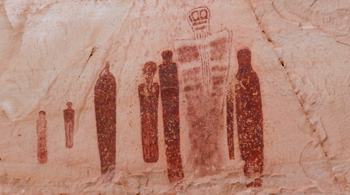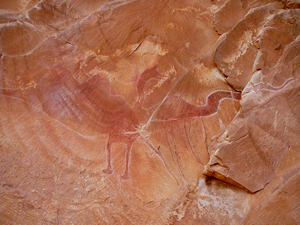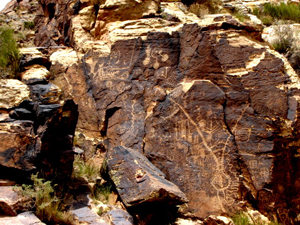This article may include affiliate links. If you click a link and make a purchase, Utah Outdoor Activities may receive a small commission at no extra cost to you. We only recommend products or services we personally use. FTC Affiliate Disclosure.

Native American rock art can be found throughout Utah. In fact, Utah is home to hundreds of thousands of individual examples of rock art. Many of the state’s most acclaimed sites are found in southern Utah, with popular locations, including Cedar Mesa, Sego Canyon and Indian Creek Canyon.
Of course, no discussion of Utah rock art is complete without mentioning Nine Mile Canyon. Stretching between the cities of Wellington and Myton, it’s a 46-mile-long trek back through time. The canyon is full of Fremont and Ute rock art, as well as historical structures. While the art is beautiful, it’s the concentration of rock art that sets Nine-Mile Canyon apart from other areas. Known as "the world’s longest art gallery," there are more than 1,000 rock art sites displaying more than 10,000 individual images.
The rock art from Nine Mile Canyon has been featured worldwide in publications like National Geographic. While many of the rock art sites are discretely hidden throughout the canyon, there are also enormous panels of rock art located just a stone’s throw from the road. So whether you’re an intrepid explorer, or on a family outing, you’re guaranteed to see plenty of art.

One of Utah’s most famous rock paintings, often referred to as the “Black Dragon,” made national news last year. Black Dragon Canyon is home to a strange pictograph of a bird-like creature. Some people speculated that it was a dragon or pterodactyl. But experts using cutting edge technology, including a portable X-ray fluorescence device, have determined the bizarre painting is actually a composite of multiple images.
The rock art found in Utah generally falls into two categories: petroglyphs, which are carved or chipped into rock, and pictographs, which are painted onto the surface of the rock.
Locations to View Utah's Rock Art
Nine Mile Canyon - A Journey into the Past
Known as Utah’s outdoor museum, Nine Mile Canyon is home to an abundance of well-preserved rock art. For 8,000 years people have populated Nine Mile Canyon. The earliest inhabitants were the Fremont Culture.

The Buck Horn Wash Ancient Petroglyphs and Pictographs
2000 years ago ancient Indians pecked and painted this rock. The peckings on the rock are called “petroglyphs”, and the paintings on the rock are called pictographs. These drawings are on the cliff face right next to the main road through “The Buck Horn Wash”.
Fremont Indian State Park and Museum was established by the Utah Legislature in 1985 to preserve Clear Creek Canyon's treasury of rock art and archaeological sites. In November 1983, during construction of Interstate 70 through Clear Creek Canyon, the largest known Fremont village was discovered.
Fremont Indian Petroglyphs - Dinosaur National Monument
Stop #13 and #14 on the Tilted Rocks Auto Tour will give you a chance to view several Fremont Indian Petroglyphs high on the stone cliffs. This rock art is said to be over 1000 years old so be sure not to touch the art itself or the rock around the art.

Dry Fork Canyon - Native American Petroglyphs
The rock art located up Dry Fork Canyon is world renowned and located along a 200-foot-high "Navajo Formation" sandstone cliff. These petroglyphs are located on the Sadie McConkie Ranch, a private property, but have remained accessible to the public, all they ask is that visitors do not damage the sites, and obey all signs.
The Great Stone Face - Millard County
Located along the roadside just before the parking area is the Great Stone Face Petroglyphs site. The meaning of these writings is unknown, but some authorities think these symbols were an agreement dividing water and hunting rights among the Indians of the lower Sevier River area.
Ute Indian Petroglyphs - Arches National Park
This wall of petroglyphs is located in Arches National Park, just off the Delicate Arch hiking trail. As you make you way up the trail to Delicate Arch you will see a small trail that forks off the main trail.
The Parowan Gap features over 90 panels of petroglyphs with some believed to be thousands of years old. The Gap is a quick detour off of I-15 and great place to visit for those traveling south towards Saint George or north to Salt Lake City.
Newspaper Rock Recreation/Historic Site
The Newspaper Rock Historic Site in San Juan County, Utah, is a rock panel displaying one of the largest known collections of petroglyphs. The rock face is 200-square feet and records approximately 2,000 years of early human activity.
Located within the Bloomington Petroglyph Park are several large boulders covered in petroglyphs. Some of the rock art has faded away from exposure to the elements, while other carvings stand out, as if they were carved recently. Many of the carvings appear to be those of human and animal forms. The many squiggly lines, and round circles, may represent early trail maps. As you walk around the boulders, take the time to look high and low. I think you will be surprised of just how many cravings are on these few boulders.
Rock Art Sites in the Moab Area
We hope you enjoyed this information. For more outdoor activities, please connect with us on YouTube, Facebook and Instagram. Help us keep this site up and running by visiting our online store which features outdoor themed gifts, decor and more. Thank you for visiting and for your ongoing support!